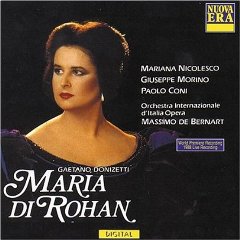Gaetano Donizetti - Maria di Rohan (2000)
Gaetano Donizetti - Maria di Rohan (2000)

Disc 1 1.Sinfonia 2.Coro: Ed è ver (1. Akt) 3.Recitativo e Cavatina: Quando il cor da lei piagato 4.Scena e Cavatina: Cupa fatal mestizia 5.Scena e Ballata: Per non istar in ozio 6.Scena e Cavatina: Gemea di tetro carcere 7.Scena e Finale I 8.Recitativo ed Aria: Alma soave e cara (2. Akt) Disc 2 1.Cavatina: Son leggero è ver d'amore 2.Scena e Duetto: Ah no, t'inganni 3.Scena e Duetto finale II 4.Preludio, Scena e Duetto: A cosi santo affetto (3. Akt) 5.Scena e Preghiera: Avvi un Dio 6.Scena ed Aria: Bella e di sol vestita 7.Scena e Duetto: So per certo il tuo bel core 8.Scena e Terzetto finale Maria, contessa di Rohan – Mariana Nicolesco Riccardo, conte di Chalais – Giuseppe Morini Enrico, duca di Chevreuse – Paolo Coni Armando di Gondì – Francesca Franci Il visconte di Suze – Vincenzo Alaimo De Fiesque – Giacomo Colafelice Coro Filarmonico Slovacco di Bratislava Orchestra Internazionale d'Italia Opera Massimo de Bernart – conductor
Maria di Rohan was Donizetti's chosen subject for his second opera for the Kärntnertor Theatre in Vienna where it was premiered in June 1843 in the presence of the Austrian imperial family and received enthusiastically with what the composer described as a sea of applause. The story is set in Paris during the reign of Louis XIII. Maria is secretly married to the Duke of Chevreuse. When her husband kills the nephew of the powerful Cardinal Richelieu she begs an ex-lover, the Count of Chalais, to intercede for him. Old flames are rekindled and her husband challenges Chalais to a duel. Rather than kill Maria's husband he turns the pistol on himself. Maria asks her husband to kill her. Instead he condemns her to a life of disgrace.
After decades of neglect Maria di Rohan was revived in the second half of the twentieth century with performances in Europe and America, often involving the renowned singing actress Renata Scotto. Regrettably, she does not feature on this recording made at the Festival della Valle d'Itria in the ancient town of Martina Franca at the heel of Italy where performances take place in the open air in the courtyard of the Ducal Palace. The acoustic of recordings made there is often influenced by the presence of reflections, or otherwise, from the scenery flats in use. It seems to my ears that this is a factor in the recorded quality and in the response of the singers in this performance where they often sound strained. The tenor, Giuseppe Morini, is the same as in the recording of Lucia di Lamermoor and is particularly guilty in this respect. As Maria, Marianna Nicolesco sings strongly but with variable diction whilst Paolo Coni as Chevreuse maintains his strong tone and adds good characterisation. But it is the music itself that distinguishes Maria di Rohan from most of the composer's previous works. The added thrust of the orchestration has been attributed to the Donizetti's presence at the premiere of Verdi's Nabucco. Certainly its forward musical momentum marked a break from the earlier bel canto tradition. As I indicate above, Donizetti seemed to have made an initial move from that tradition with his Poliuto. What he seems able to do in Maria di Rohan is better to marry the old and the new. This was his last Romantic melodrama, a genre that he did so much to develop and where, perhaps, it achieves its zenith in the last act. --- Robert J Farr, musicweb-international.com
Maria di Rohan, one of Donizetti’s last operas, is also one of his leanest. It was composed for Vienna in 1843 for an audience that preferred its story-telling to be direct and relatively unadorned; later that year it was presented in Paris in a revised version, with the minor tenor role of Gondi, a political figure, transposed for mezzo-soprano and enlarged. The entry of this trouser figure does not help the opera dramatically, and this new CD version, unlike the others available, reverts to the original. (The music for the revised role of Gondi, as well as a duet for Maria and Chalais, is included as an appendix to the final CD.)
The opera takes place during the time of Louis XIII with the figure of Cardinal Richelieu looming large, although he never appears. The Countess Maria di Rohan (soprano), lady-in-waiting to Queen Anne, is married to Chevreuse (baritone), an enemy of Richelieu’s, but she is conflicted by the presence of her former lover, Chalais (tenor, a friend of Richelieu’s), who does not know that she’s been married to Chevreuse for more than a year. (Her mother made her marry Chevreuse for political reasons.) There’s plenty of political intrigue as well, and a duel or two. Donizetti claimed to have composed the opera in eight days; it certainly has an economy of style and dramatic thrust that implies intense work.
The revision adds arias and cabalettas–nice to hear, good show pieces–but waters down the plot, which is complex enough and includes a secret letter, a disguise, and general confusion. At the end, Chalais dies and Maria and Chevreuse remain in their loveless marriage–a very odd plotline for a bel canto opera. Watching it, I should imagine, makes more sense than just listening to it, but the music is first-rate Donizetti. --- Robert Levine, classicstoday.com
download (mp3 @320 kbs):
yandex 4shared mega mediafire zalivalka cloudmailru uplea








